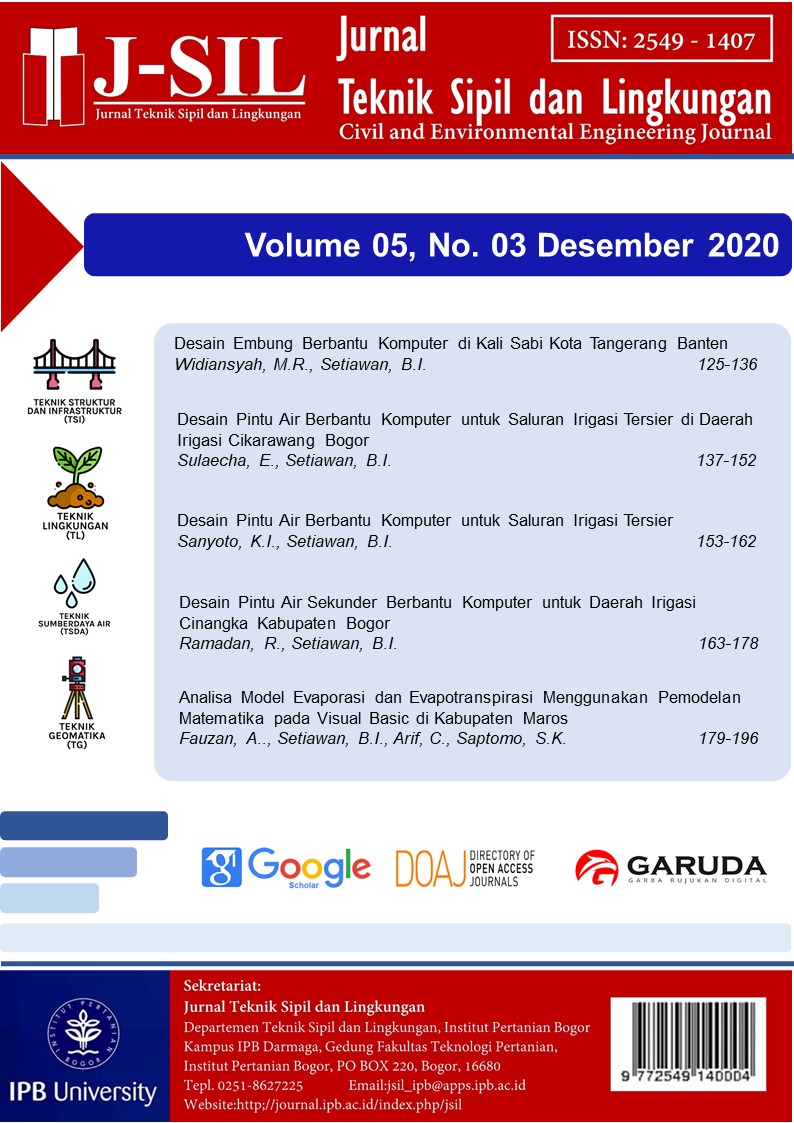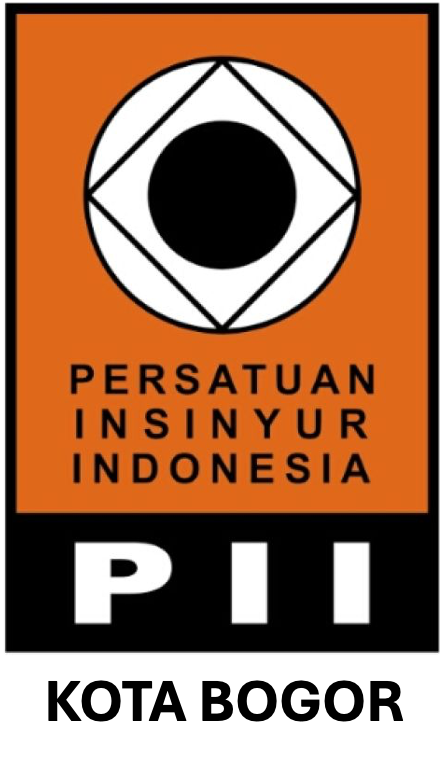Desain Pintu Air Berbantu Komputer Untuk Saluran Irigasi Tersier
Computer Aided Design for Sluiced Gate in Tertiary Irrigation Canal
Abstract
The effort of human creativity in the field of hydraulics in overcoming the problem of irrigation, one of which is using floodgates. The discharge from the floodgates needs to be adjusted to the water needs of the plant. However, due to the long design process, the computer aided design of sluice on tertiary irrigation channels is needed in order to be able to set the optimum dimensions and output discharges of crops water needs with fast design time. The tool used in the form of a computer device with Ms Excel and AutoCAD software and materials used were secondary data, that is water needs of local varieties of rice plants in Mangkung, Rambitan, NTB on an area of 50 ha. The data’s then calculated and the largest discharge is 0.12 m3/s with plant evapotranspiration of 5.10 mm/day and 6.43 mm/day of effective rainfall, meanwhile the smallest is 0.02 m3/s with plant evapotranspiration of 3.17 mm/day and 3.47 mm/day of effective rainfall. The dimensions of the steel sluice gates obtained are width of sluice gate 0.40 m, height of sluice gate is 0.80 m with an estimated cost of making Rp 7,547,000 per one sluice. The dimensions of the GFRP sliding sluice gates are width of sluice gate 0.50 m, height of sluice gate is 0.75 m with an estimated construction cost of Rp 7,547,000 per one sluice.
Downloads
References
Rizal F, Alfiansyah, Rizalihadi M. Analisis perbandingan kebutuhan air irigasi tanaman padi metode konvensional dengan metode SRI organik. Jurnal Teknik Sipil. 2014; 3(4): 67-76.
Laumal FE, Hattu EP, Nope KN. Pengembangan pintu air irigasi pintar berbasis arduino untuk Daerah Irigasi Manikin. Jurnal Rekayasa Elektrika. 2017; 13(3): 139-144.
Rif’ah MI, Wibisono MA. Pengembangan computer aided design (CAD) warna batik. Forum Teknik. 2016; 37(1): 41-48.
Ningsih DH. Computer aided design / computer aided manufactur [CAD/CAM]. Jurnal Teknologi Informasi DINAMIK. 2005; 10(3): 143-149.
[KemenPU] Kementrian Pekerjaan Umum. Kriteria Perencanaan Bagian Petak Tersier: KP-05. Jakarta(ID): Direktorat Irigasi dan Rawa, Direktorat Jenderal Sumber Daya Air, Kementerian Pekerjaan Umum; 2013.
Bos MG. Discharge measurement structures (Third Revision). Wageningen(NL): International Institute for Land Reclamation and Improvement/ILRI; 1989.
Yen JF, Lin CH, Tsai CT. Hydraulic characteristics and discharge control of sluice gates. Journal of the Chinese Institute of Engineers. 2001; 24(3): 301-310.
Lin CH, Yen JF, Tsai CT. Influence of sluice gate contraction coefficient on distinguishing condition. Journal of Irrigation and Drainage Engineering. 2002; 128(4): 249-252.
Linsey RK, Franzini JB. Water Resources Engineering. New York(US): Mc Graw Hill Book Co; 1979.
Purba JH. Kebutuhan dan cara pemberian air irigasi untuk tanaman padi sawah (Oryza sativa L.). Jurnal Sains dan Teknologi. 2011; 10: 145-155.
[KemenPU] Kementrian Pekerjaan Umum. Kriteria Perencanaan Jaringan lrigasi Bagian Jaringan Irigasi: KP–01 (Revisi 2010). Jakarta(ID): Direktorat Irigasi, Direktorat Jenderal Sumber Daya Air, Kementerian Pekerjaan Umum; 2010.
Copyright (c) 2020 Jurnal Teknik Sipil dan Lingkungan

This work is licensed under a Creative Commons Attribution-NonCommercial-NoDerivatives 4.0 International License.
Authors who publish with Jurnal Teknik Sipil dan Lingkungan, JSIL agree to the following terms:
a. Authors retain copyright and grant the journal right of first publication with the work simultaneously licensed under a Creative Commons Attribution License that allows others to share the work with an acknowledgment of the work's authorship and initial publication in this journal.
b. Authors are able to enter into separate, additional contractual arrangements for the non-exclusive distribution of the journal's published version of the work (e.g., post it to an institutional repository or publish it in a book), with an acknowledgment of its initial publication in this journal.
c. Authors are permitted and encouraged to post their work online (e.g., in institutional repositories or on their website) prior to and during the submission process, as it can lead to productive exchanges, as well as earlier and greater citation of published work (See The Effect of Open Access).











